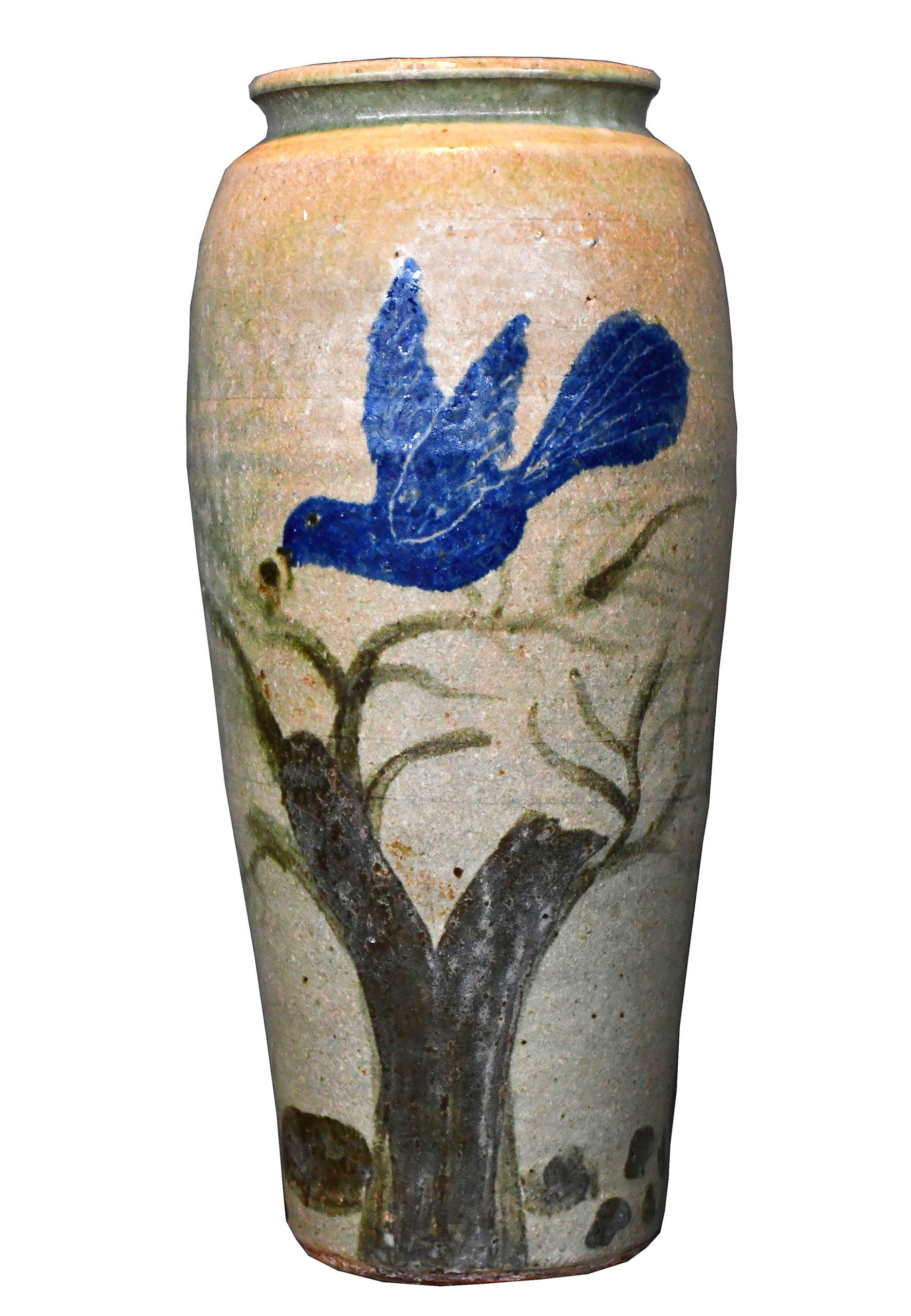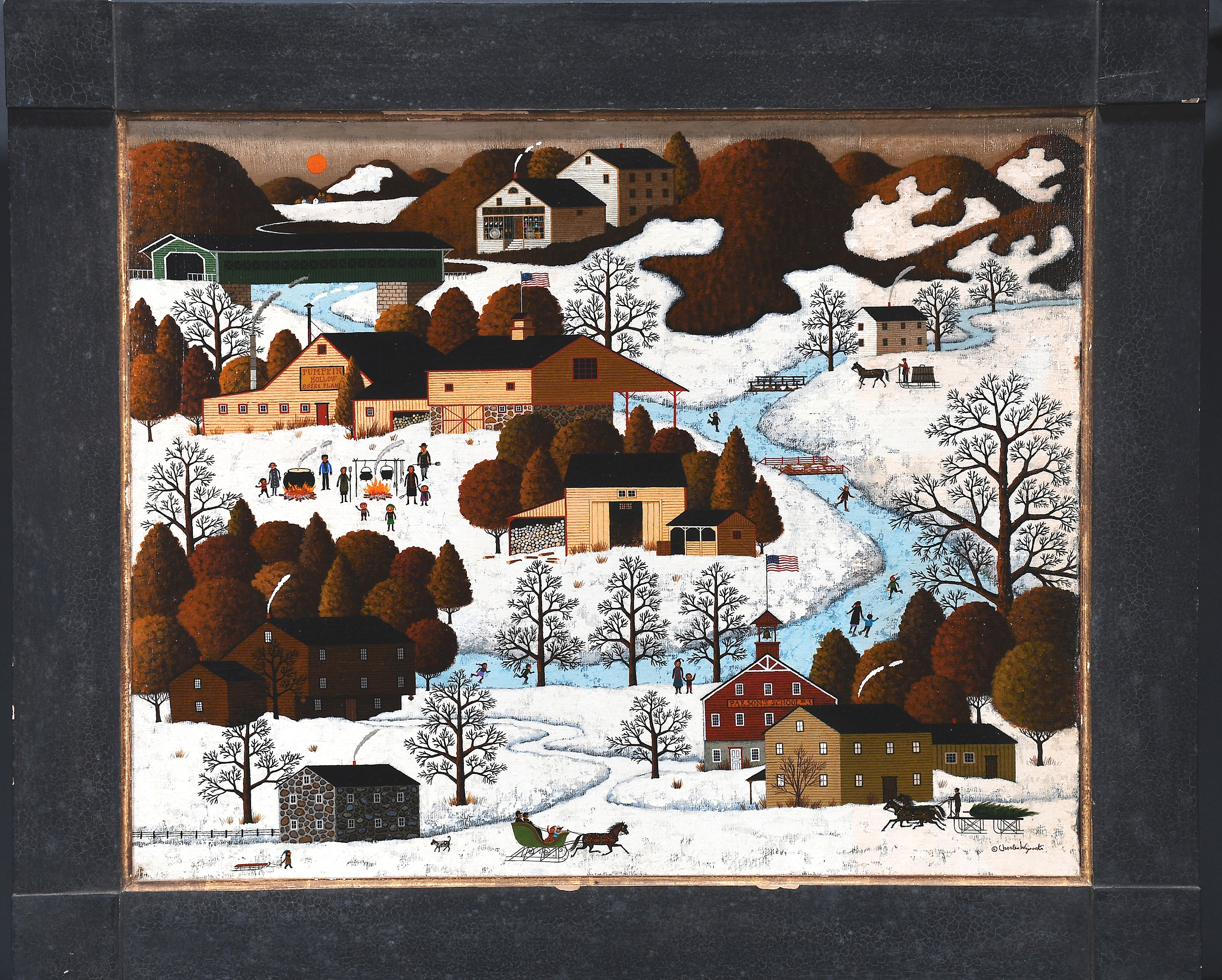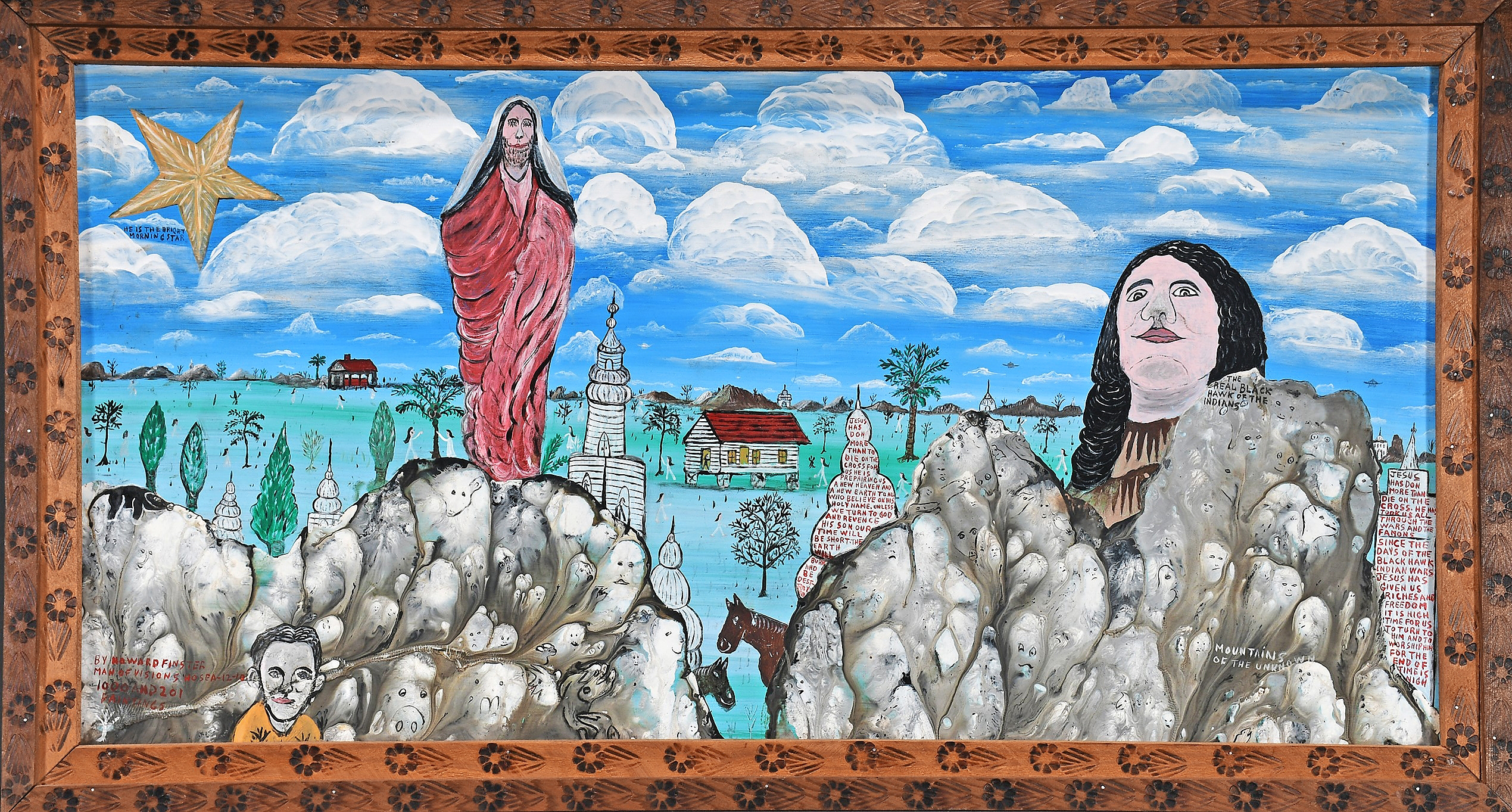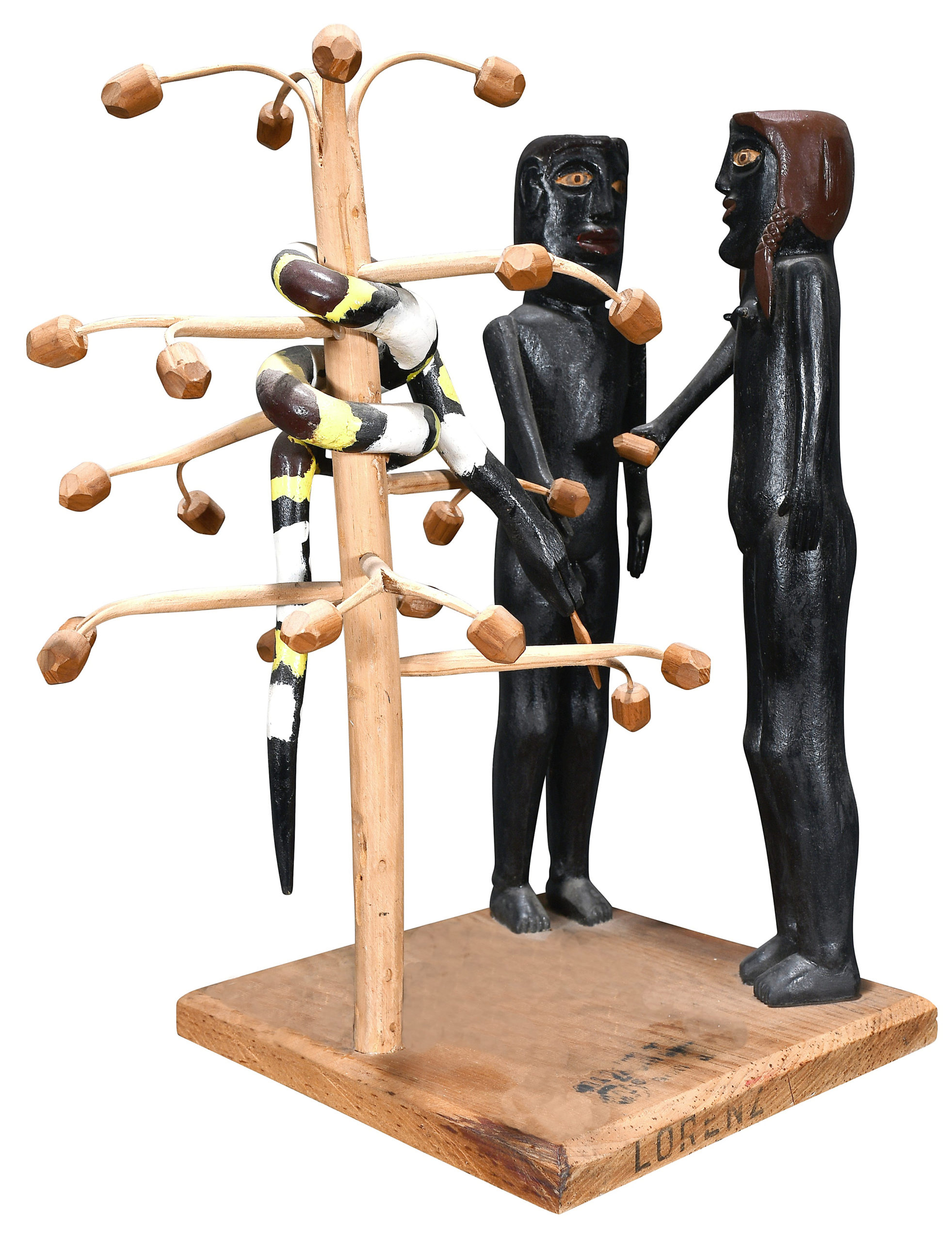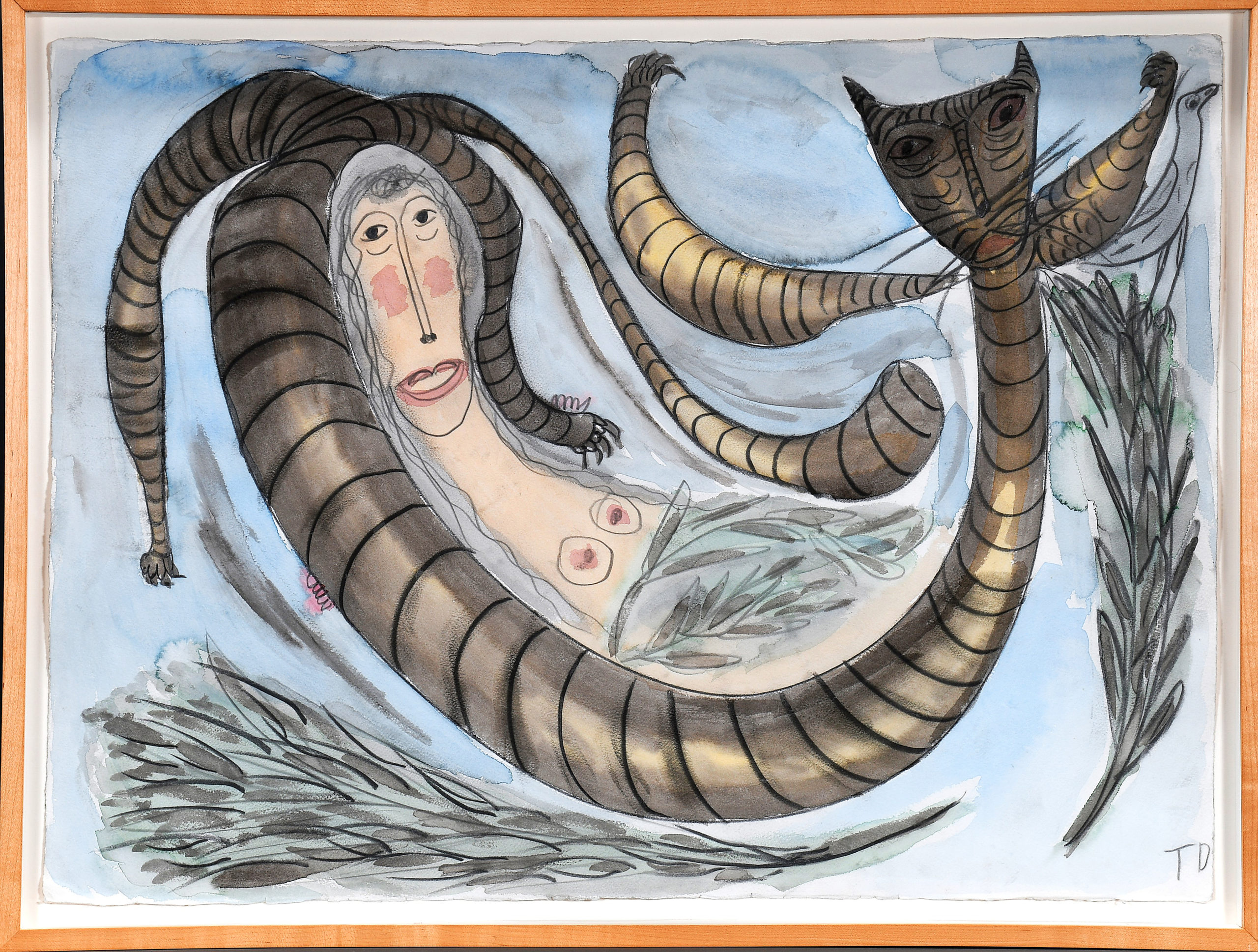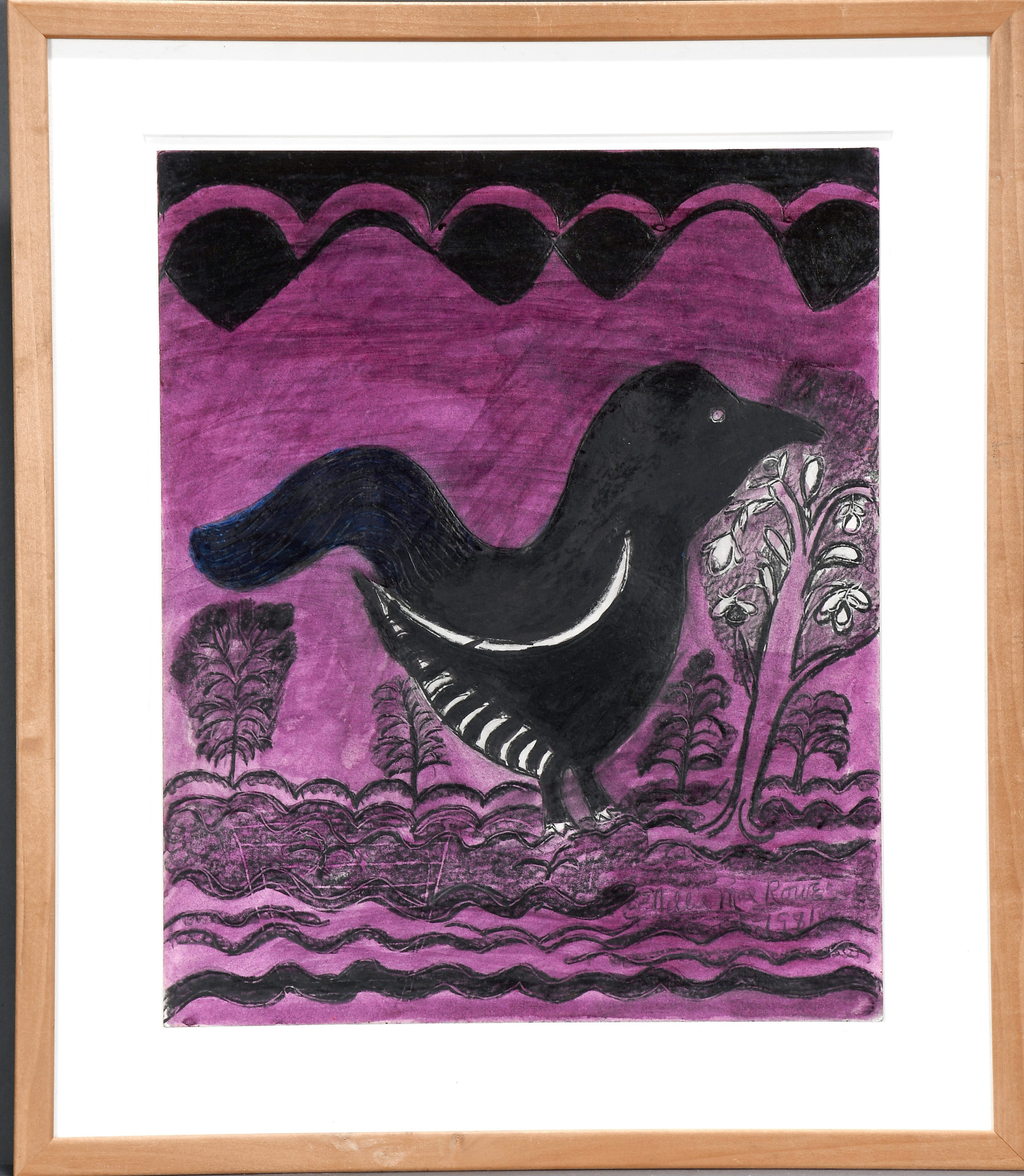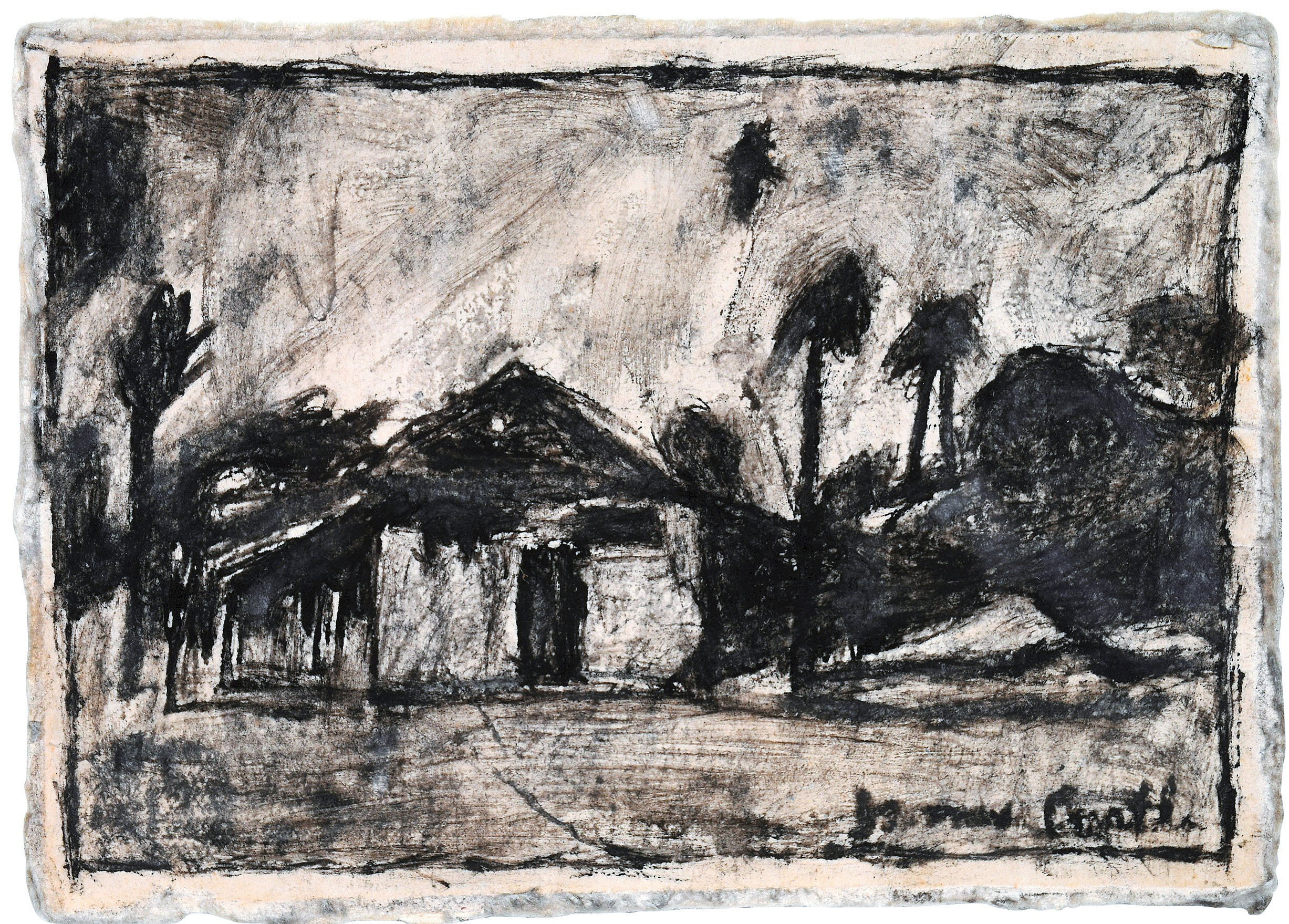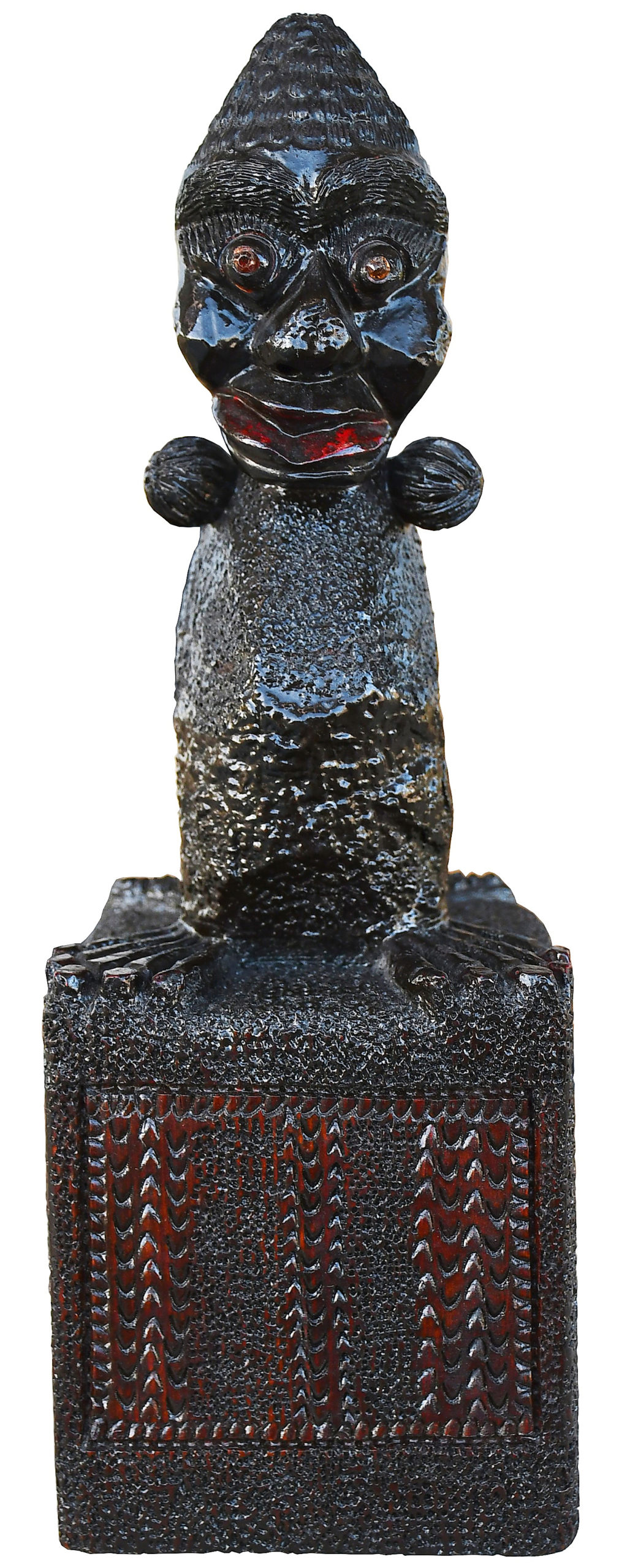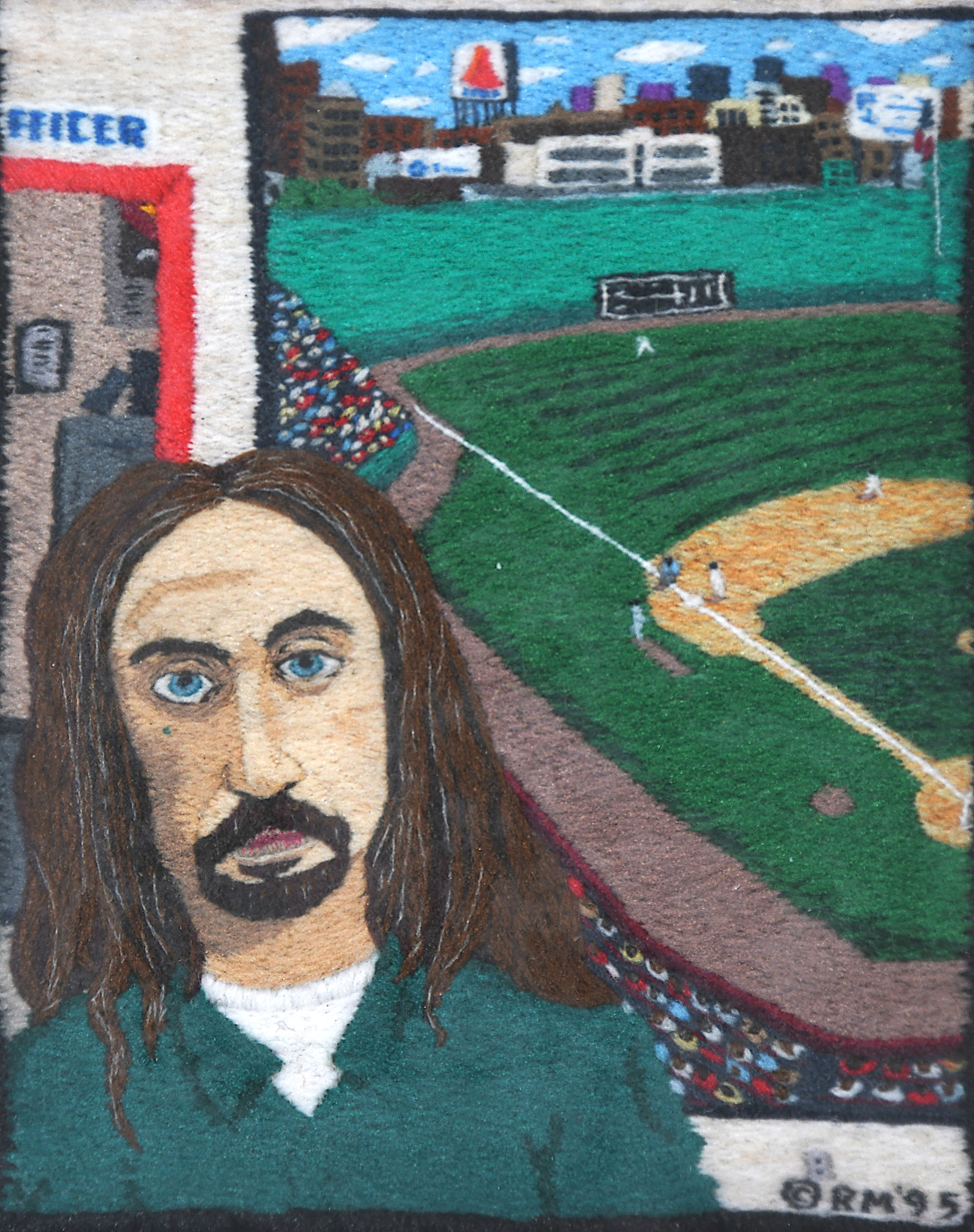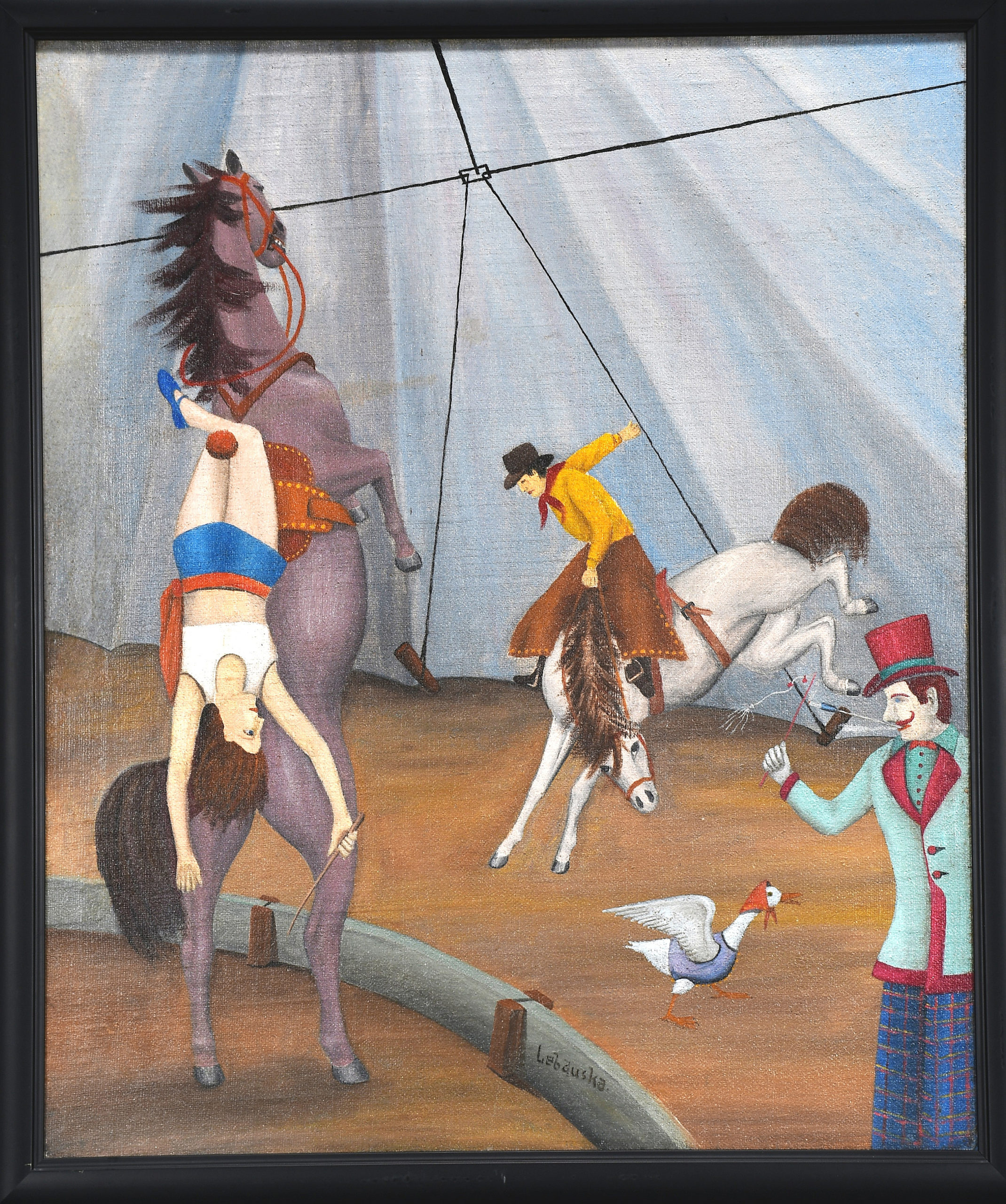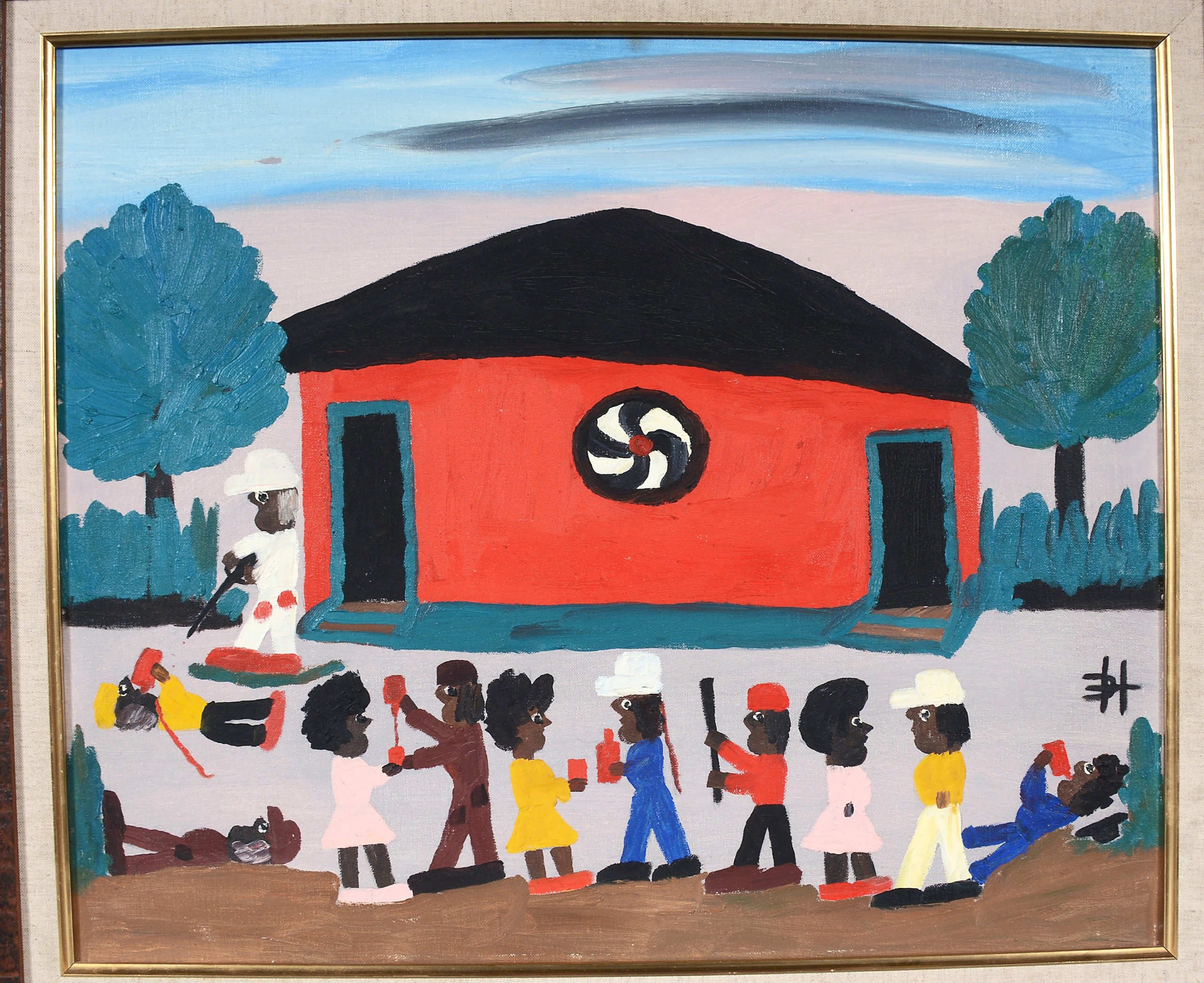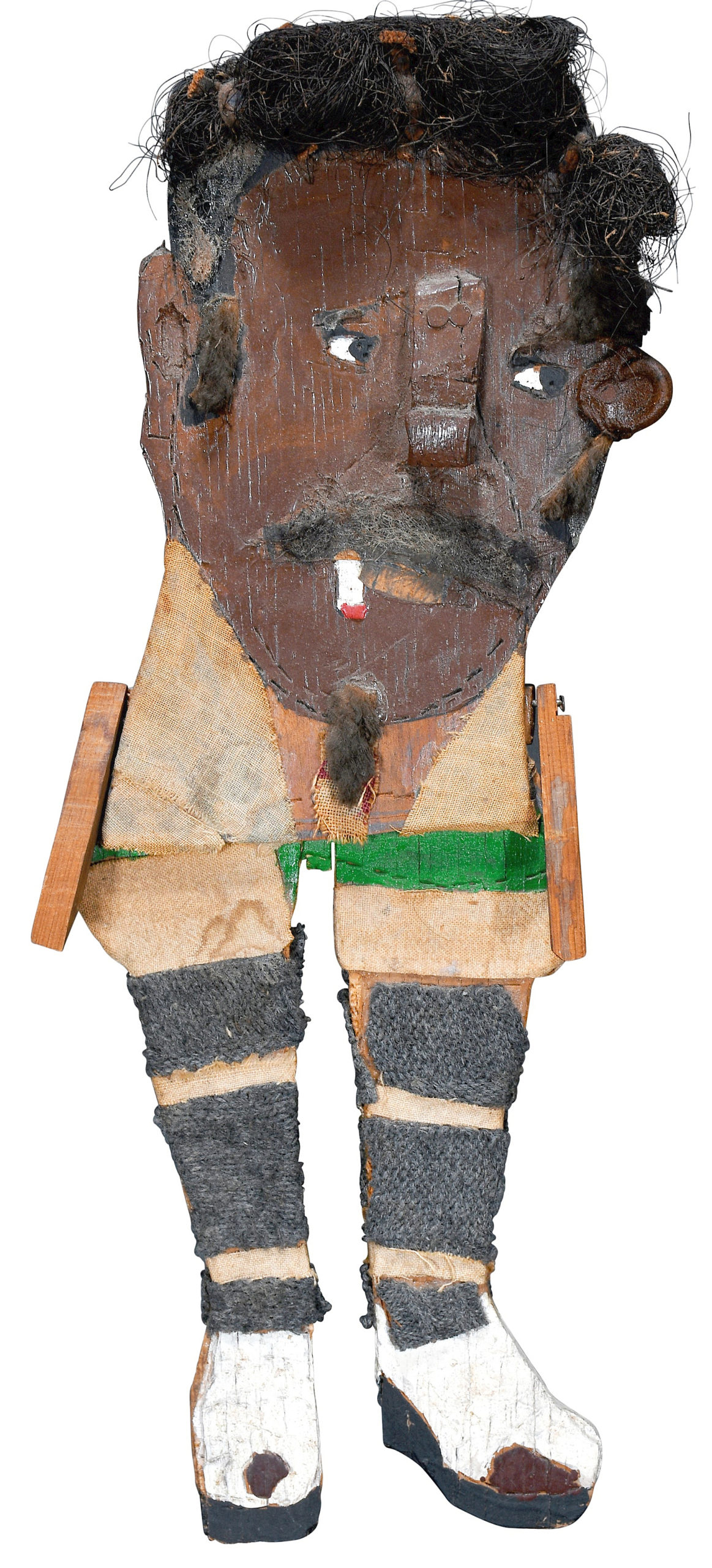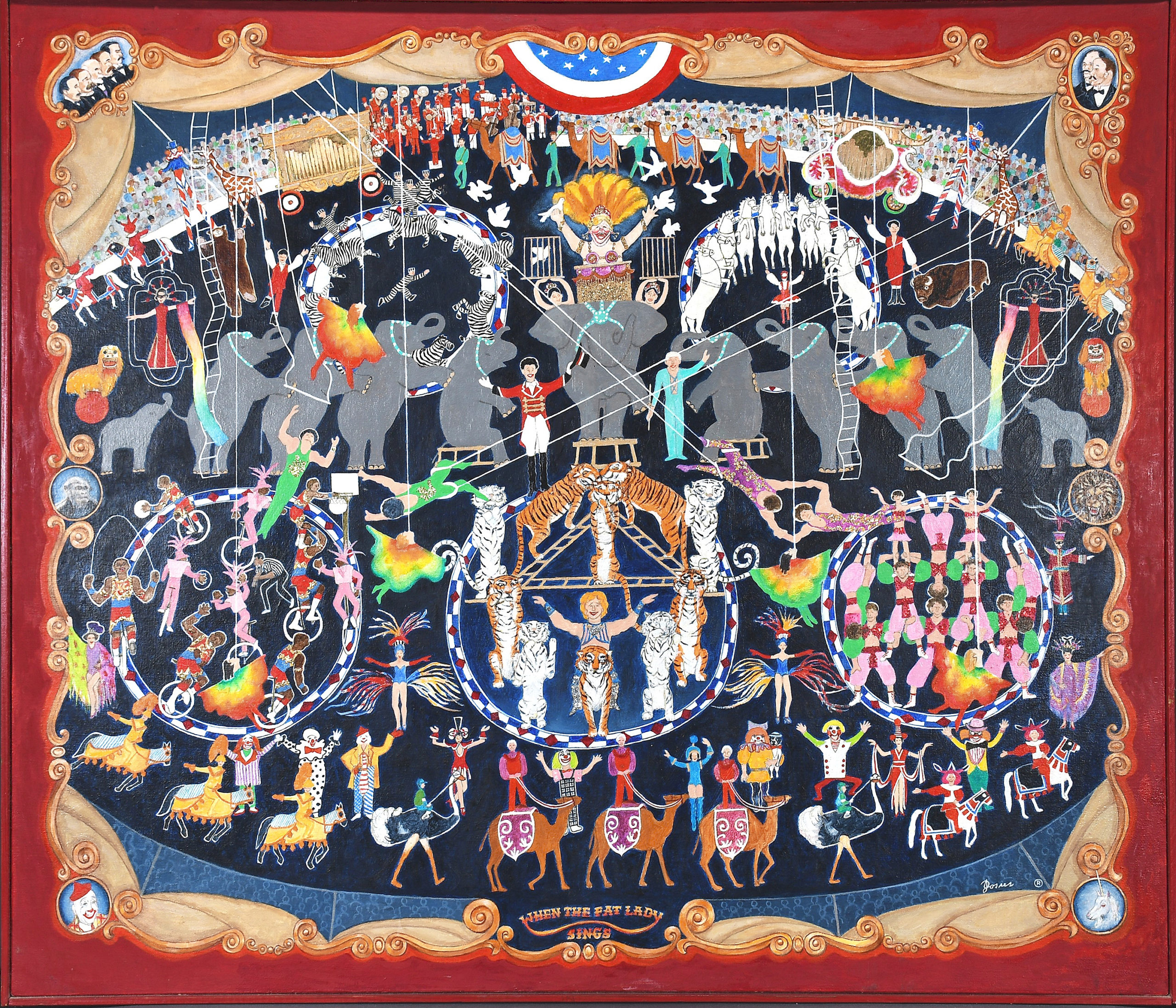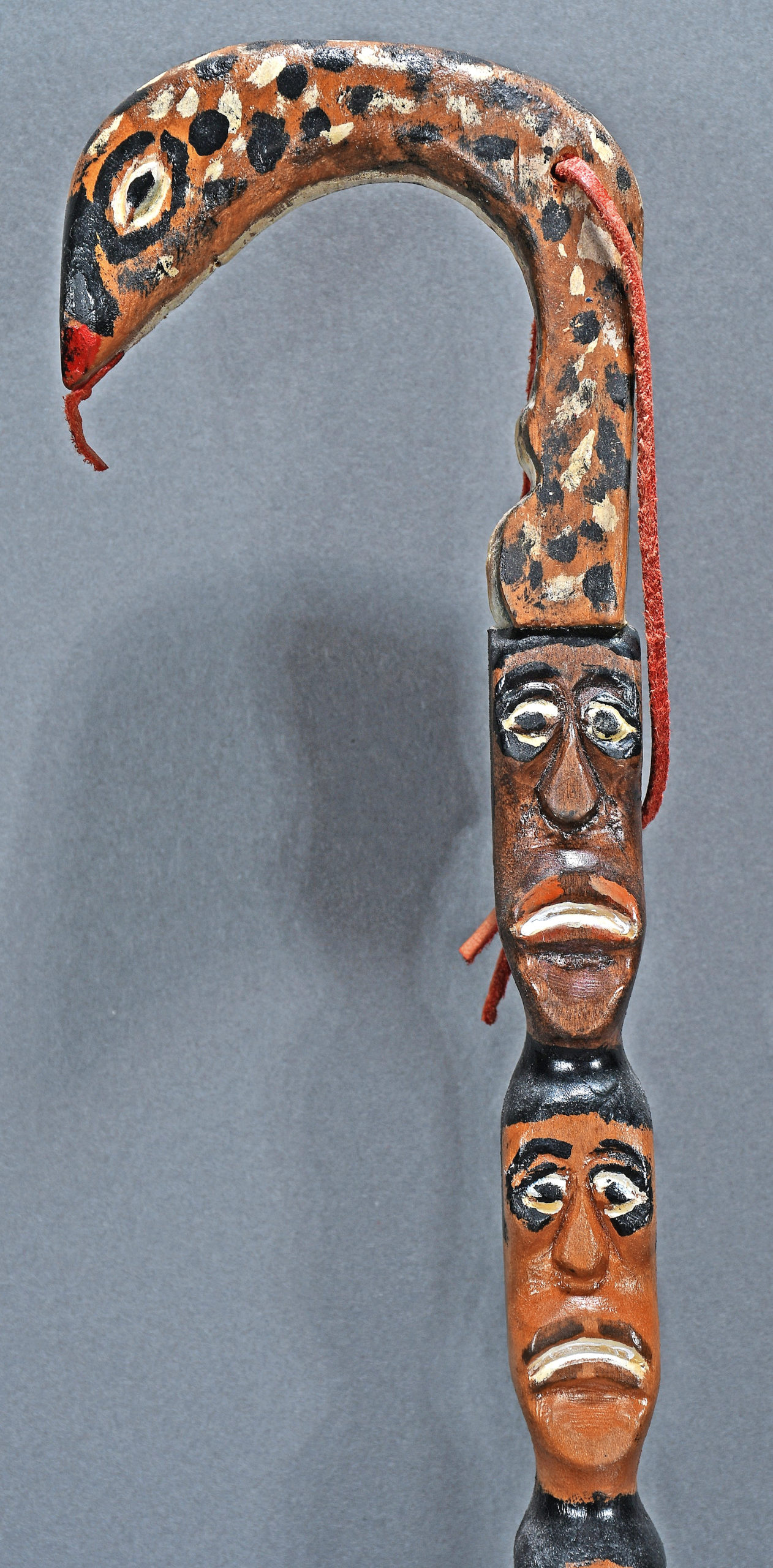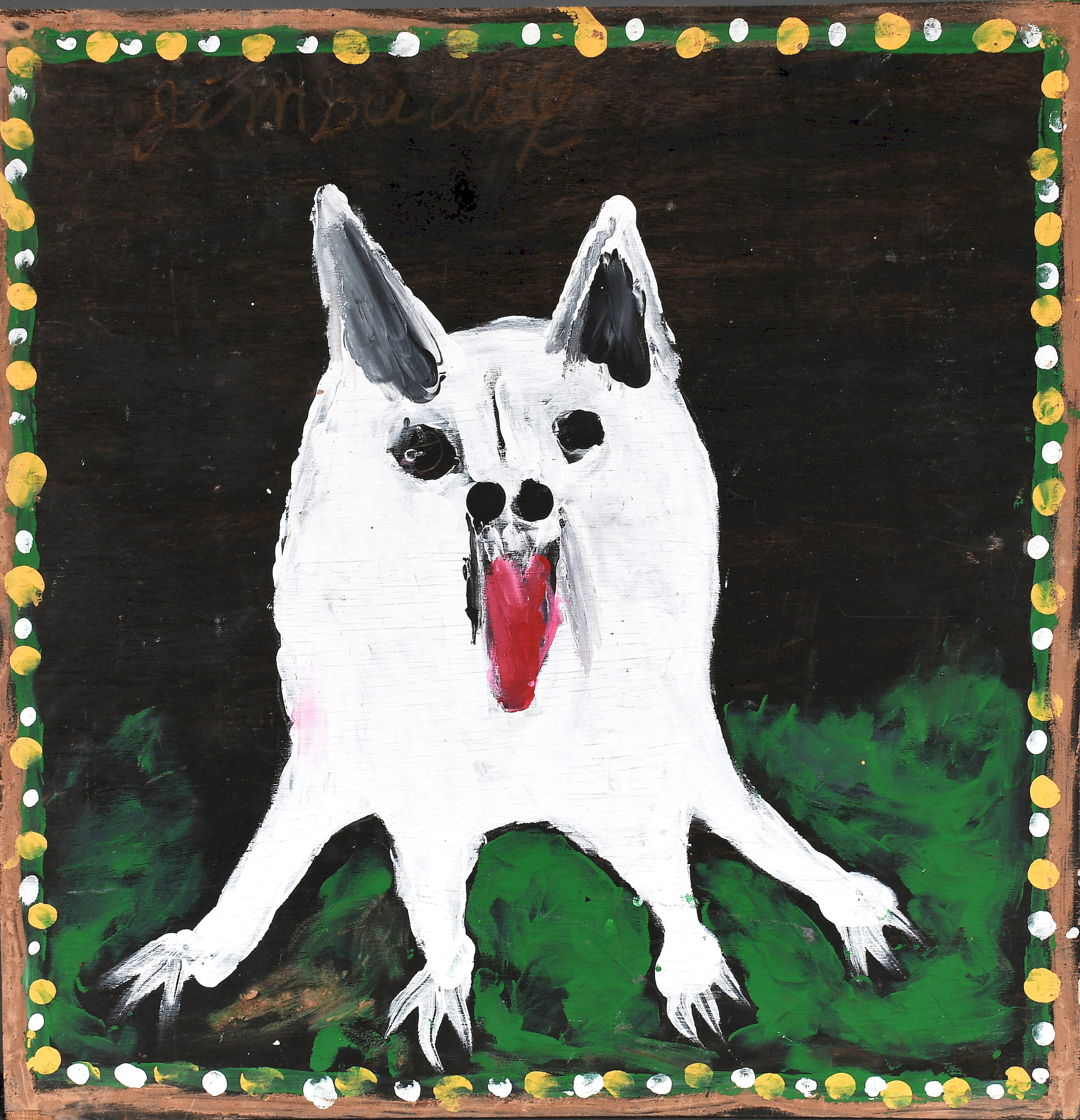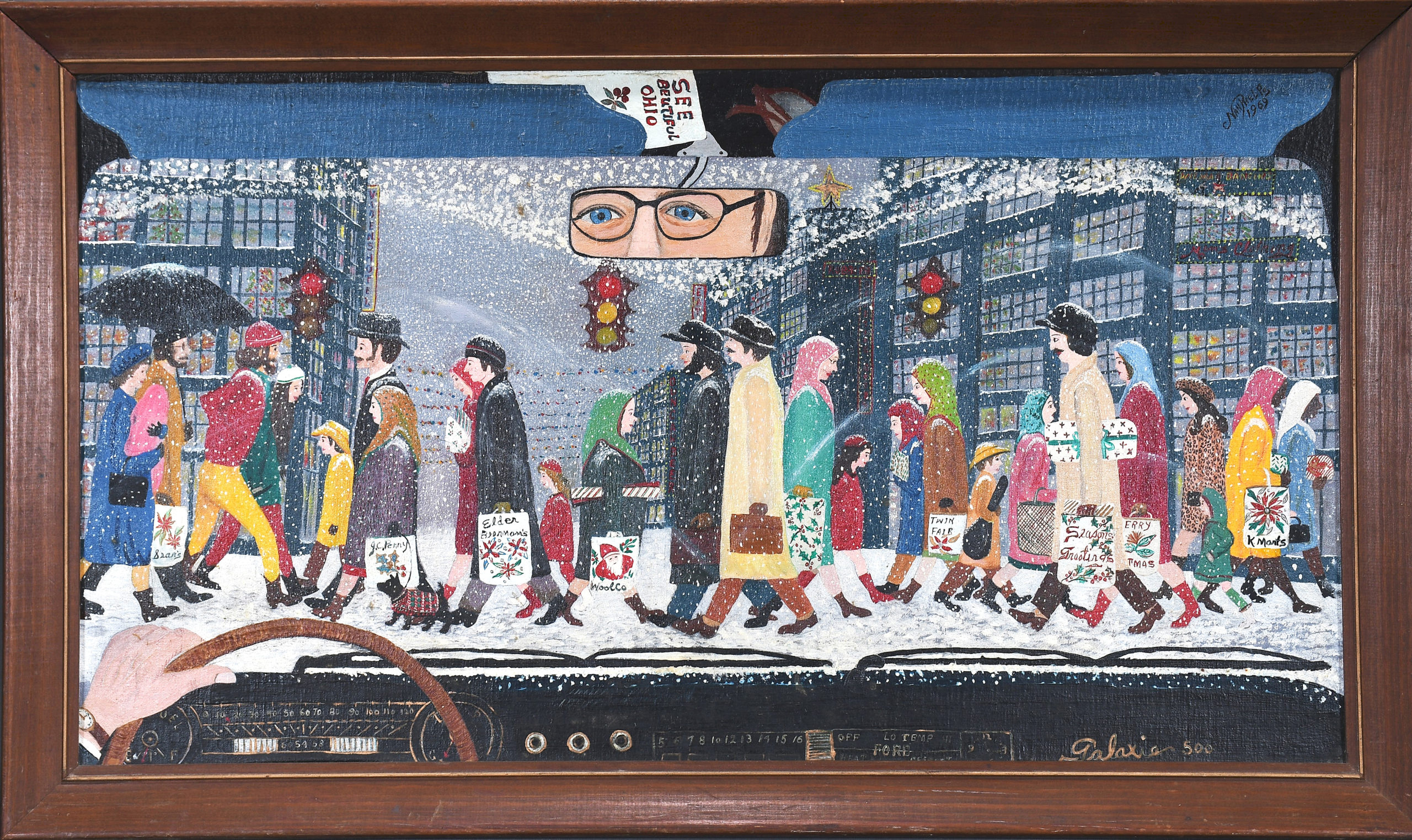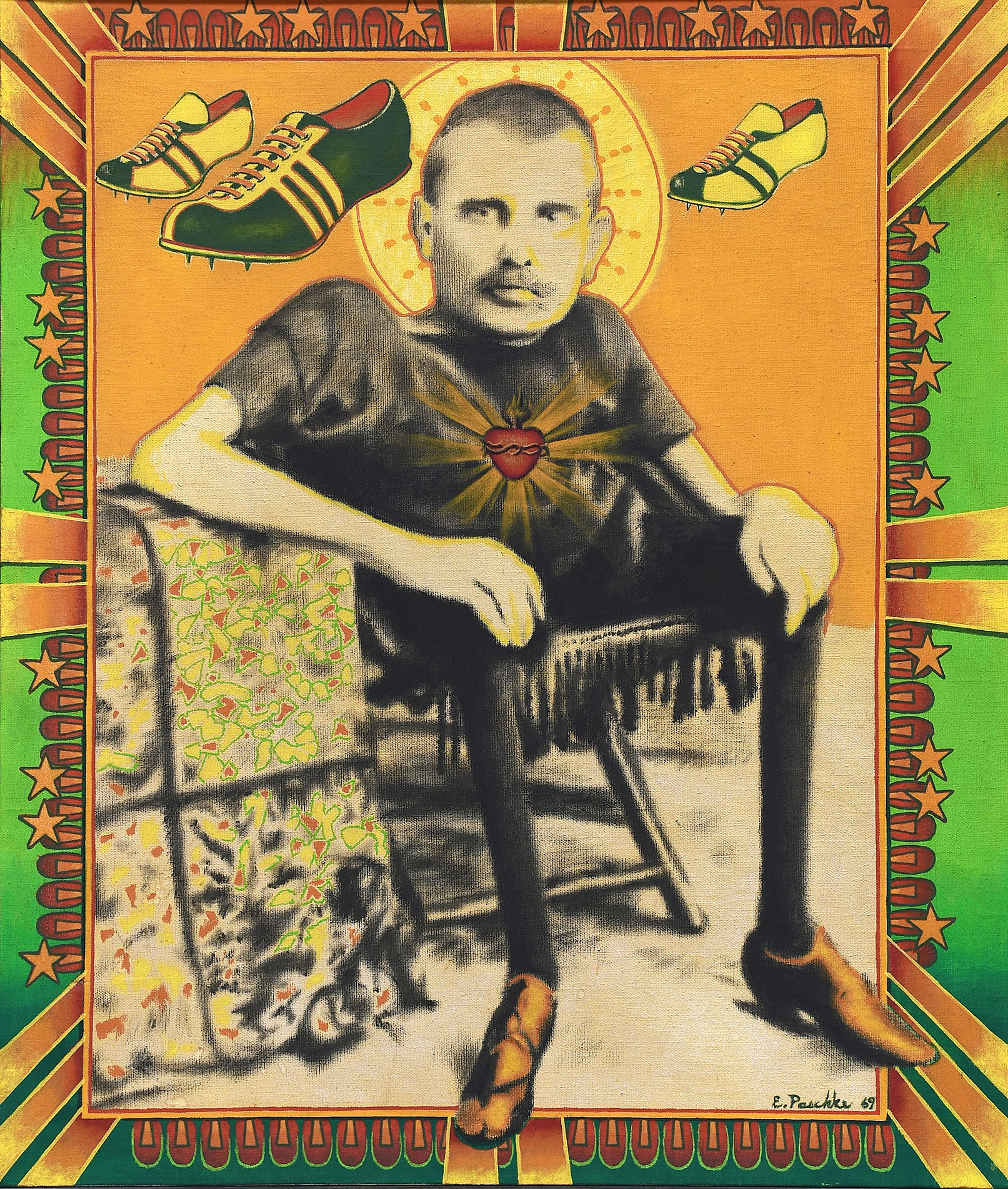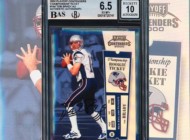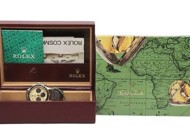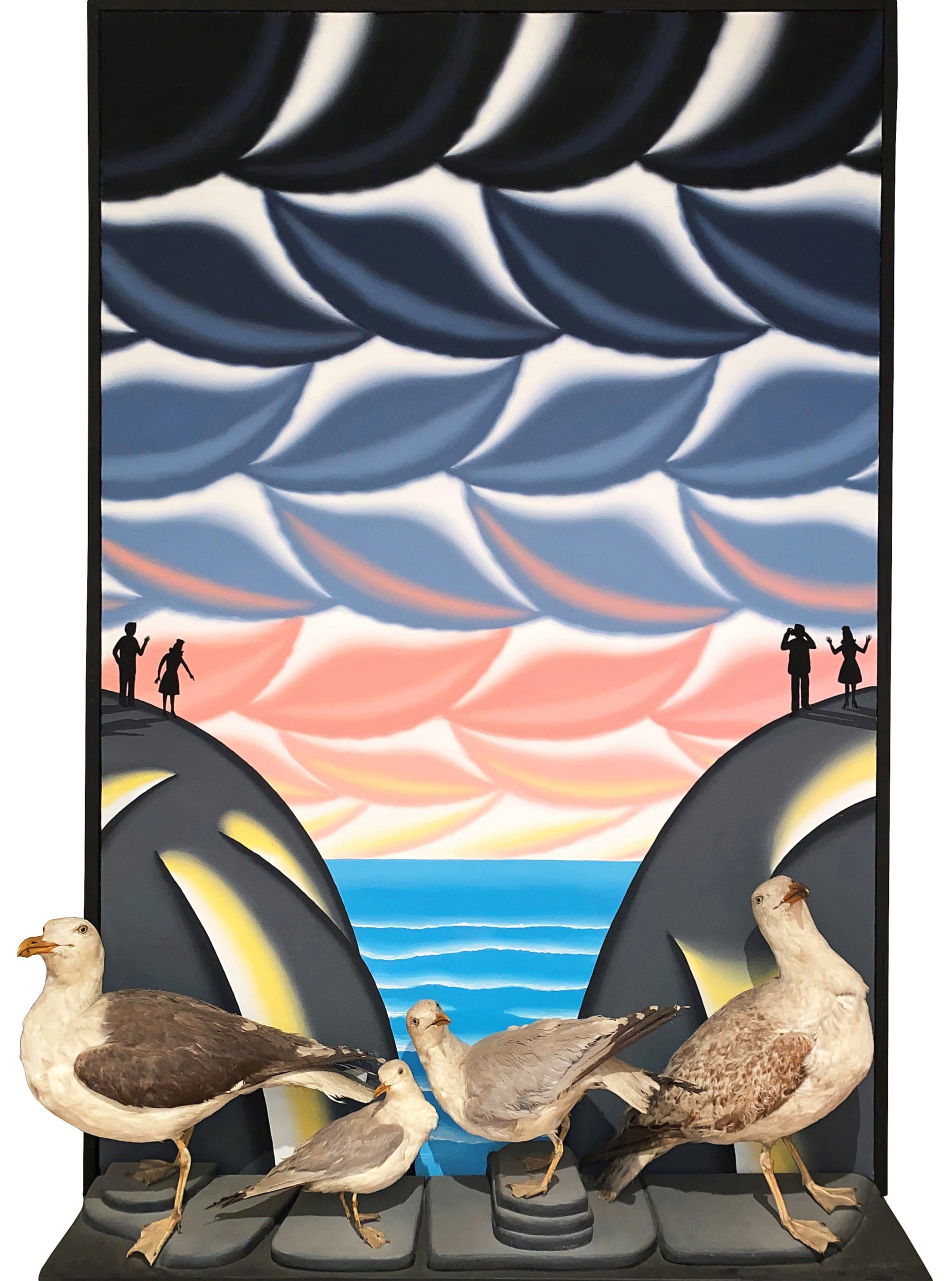
“Visit The Oregon Coast” is the first, and only, work by Roger Brown to be offered at Slotin. It topped the sale at $115,000 ($100/200,000).
Review by Marty Steiner, Photos Courtesy Slotin Folk Art
BUFORD, GA. — Slotin Folk Art’s twice annual Masterpiece Sales continue to grow and amaze. After returning to a two-day event, these auctions continue to expand the scope of their offerings. The success of that genre expansion was seen in this spring’s Self-Taught Masterpiece Sale, conducted online, though phone and absentee bidding were available as well as an in-person preview, on April 23-24. All lots offered sold to tally an overall $1.996 million.
The prominence and importance of these Self-Taught auctions drew an extensive feature article in the Atlanta Journal-Constitution, “Passion for all things Southern sparked Steve Slotin’s love of folk art” traces Steve and Amy’s passion and their entire life’s endeavor. The article traces the 30-year history of the Slotins en route to becoming one of the largest sources of folk and self-taught art.
The printed sale catalog highlighted the importance of private collections in this genre with a dedication-acknowledgement of the Russell and Barbara Bowman Collection and their active role advocating the genre. After nearly 50 years of collecting, the Bowmans are downsizing their collection, with a number of their lots included in this sale.
The structure of these Slotin sales harkens back to the earlier live two-day events. Many collectors traveled to Buford for these sales in part to visit with others of the folk and self-taught collecting family. To facilitate those who wanted to bid, buy and get on the road home, the first day included the feature items and most of the higher priced lots. Folk pottery was all grouped together at the beginning of that first day so the pottery collectors could “get and go.” That also allowed late arrivals to do their visiting and settle in for the featured lots. Many newer collectors and those capable of moderate capability looked to the second day for newer material and more modest prices.
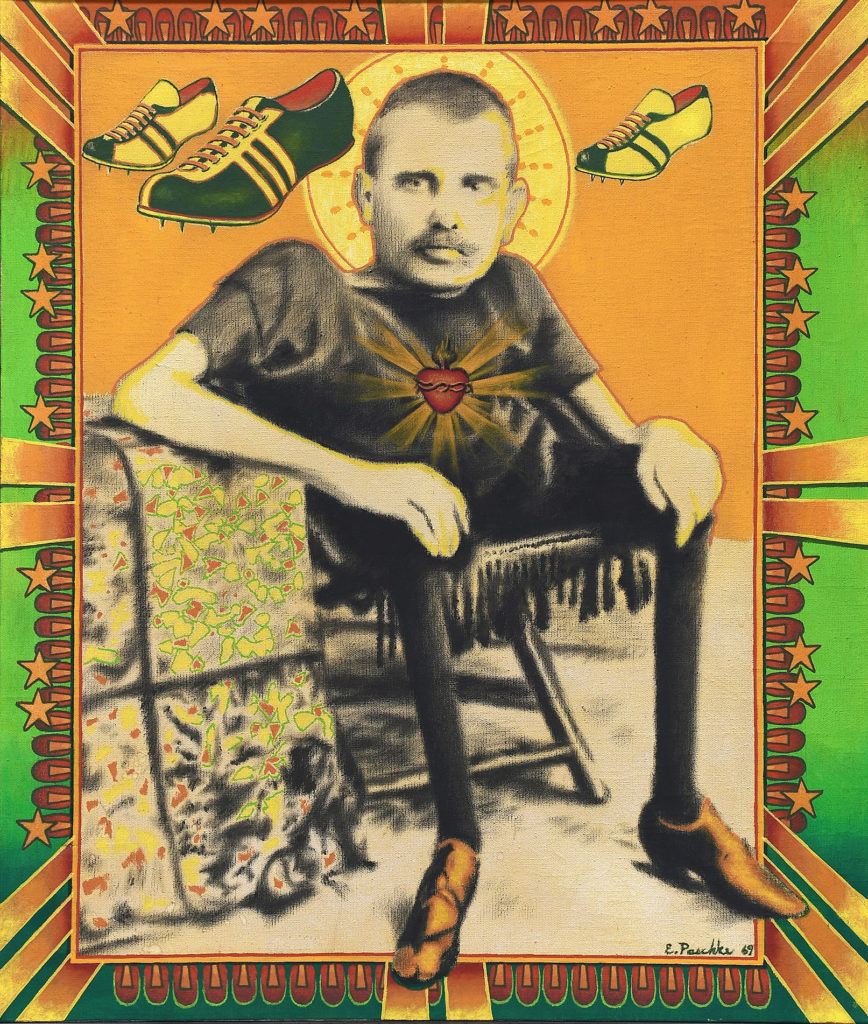
Ed Paschke’s “Holy Stick Man,” with extensive provenance, spoke directly to bidders and reached $86,250, the second highest result of the auction ($50/100,000).
With the growth of online bidding, there is now more distribution of recognized artist’s into the second day. Individual artist’s lots are generally grouped together rather than scattered through the two-day sale. Asked about the prevailing online sales and whether they would return to live, onsite sales, Steve Slotin had some interesting observations. Among these were the safety of the material. With the live sale, viewing and the packing of items for immediate removal created exposure for damage.
With more than 700 lots offered across two days, more than 200 artists were represented. As always, folk pottery opened the sale with 42 lots. Prices realized for pottery ranged from only $188 for an Otis Norris 2009 devil jug with snake form handles, to $8,125 for an early Lanier Meaders face jug with rock teeth and glazed eyes. Pottery forms included early utilitarian wares, later face forms and figurals, including pedestal roosters. Early Edgefield potters work included a four-gallon Dave Drake double lug handled jar at $6,875 that exceeded its estimate. Three unsigned Edgefield jugs sold, with a one-gallon example attributed to B.F. Landrum based on a Horse Creek Valley marking. That jug brought a respectful $1,187, selling within expectations.
Face pieces included six Lanier Meaders jugs, two B.B. Craig jugs and a pitcher, a Kim Ellington jug, along with a Bobby Ferguson four-faced jug. Six pedestal roosters included Edwin Meaders, Clint Alderman and Charlie West examples. An early (1983) ash glazed Edwin Meaders led that flock to sell within estimates, on a $1,375 bid.
Following the 42 pottery lots, the focus of the sale abruptly changed to the highest estimated lot, the Roger Brown assemblage.
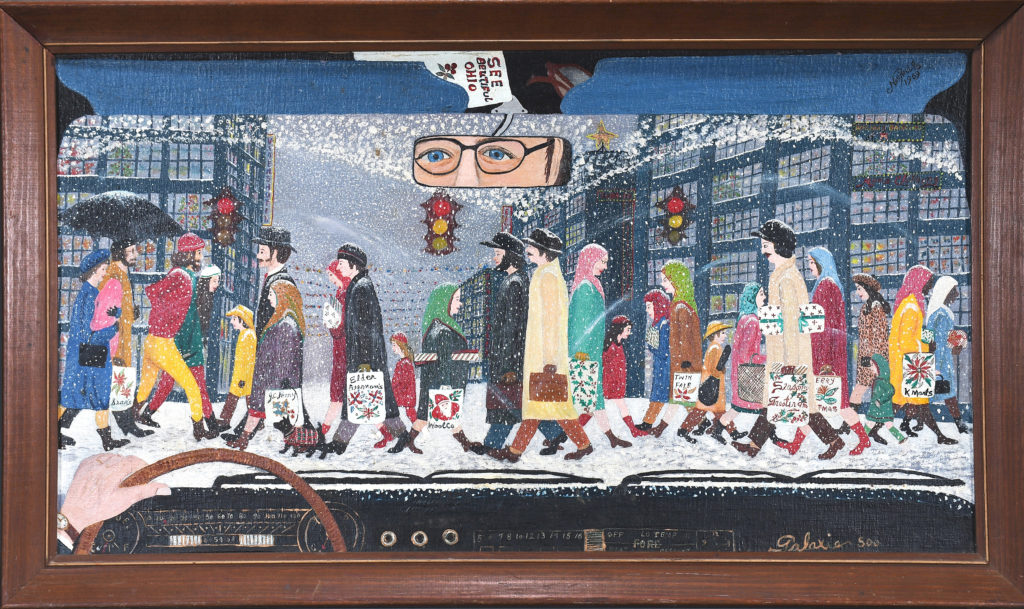
Nan Phelps presented a different view of the world with her “Christmas Shoppers Through the Windshield of the Galaxy.” Early Christmas present at $9,375 ($1/3,000).
Three of the four highest-priced lots were by artists not usually seen at Slotin Folk Art. When asked about this, Steve Slotin’s response was to point out that most American folk art comes from the South, rural areas and disadvantaged people. Many are African American, women or isolated groups of some sort. This underlines the inclusion of items by Chicago-based artists Roger Brown (1941-1997) and Ed Paschke (1939-2004). These two artists would top the prices-realized list for the sale.
Brown studied art at school in Alabama from second grade through high school, once even winning a state poster competition. After high school and moving to Chicago, he studied at the School of the Art Institute of Chicago where he received both bachelor’s and master’s degrees. Through it all, he remembered his rural Southern background and the folk and self-taught art of the area. He would later utilize some of the same techniques, including found elements and assemblages in his own work. Brown actively collected Southern folk art throughout his life leaving this collection to the Roger Brown Study Collection at the Chicago Institute. Among this collection are 36 Joseph Yoakum paintings.
Roger Brown’s 1979 “Visit the Oregon Coast” is a 52-by-74-inch oil on canvas that serves as a backdrop of an assemblage with four taxidermy seagulls mounted in the foreground. This subject of much presale discussion set the sale’s pace selling for $115,000 and within expectations.
Like Roger Brown, Paschke also was trained at the Art Institute of Chicago. He learned to paint under the disciplines of abstractionism and expressionism. Many of the students at the Chicago Institute, including Paschke, were fond of outsider and tattoo art. His “Holy Stick Man,” 1969, had been included in the 2010 Paschke retrospective at Gagosian Gallery and published in Ed Paschke by Neal Benezra (1990) earned $86,250, while his “The Optimist” closed out at $33,750.
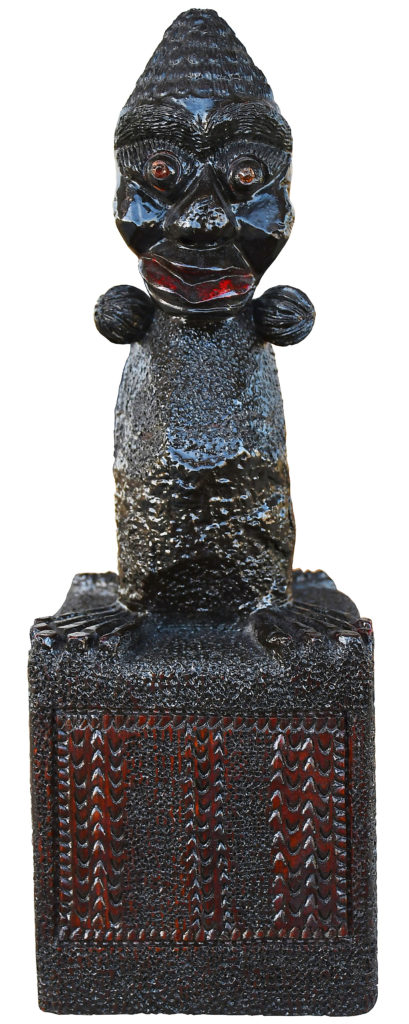
Ulysses Davis’ carved and varnished wood “Figure on a Box” found a new place to stand for $14,375 ($12/18,000).
Joseph Yoakum’s (1886-1972) presence in Roger Brown’s life and collection was no accident. Brown had visited Yoakum and other self-taught artists and became an advocate for the genre. Yoakum was also well represented in this sale with six examples, all selling at strong prices. With three of the top ten dollar lots, his “Mt McKinley Near Petersville Alaska” soared to a $36,250 peak bid, well over its estimate range. Other Yoakum travel postcard-like scenes that made the top ten were his “An Open View of a Preary (sic) Gailsburg Illinois,” that brought $13,125 and “San Fernando Valley Paso Robles California” for $20,000. All Yoakum images have his handwritten description on them and usually feature a winding road or river. He primarily worked with pastels, color pencil and ink on paper.
Clementine Hunter (1887-1987) may be one of the most recognizable folk artists. Slotin’s sale included an impressive 14 examples, all of which brought strong prices, including her “Saturday Night Juke Joint” for $14,375, more than doubling estimates. Her works were distributed across both days of this sale.
Underlining the importance of early folk, outsider and self-taught art collections is the fact that all Hunter lots in this sale came from the Gary Davenport collection with authentication by Tom Whitehead, friend and her published biographer.
The ever-present Howard Finster (1916-2001) had 27 examples offered over both days. All but a few met or exceeded estimates with his “Christ Appearing to the Blackfoot Indians” topping the list at $13,750 followed by “Pearl Granet – City of Mosola” for $10,000, doubling its high estimate.
Other noteworthy artists sold included Mattie Lou O’Kelley (1908-1997) with all four lots topping estimates, as did all four works by Lee Godie (1908-1994). Thornton Dial (1928-2016), Nellie Mae Rowe (1900-1982), Lawrence Lebduska (1894-1966), Sam Doyle (1906-1985), James Castle (1899-1977) and Jimmie Lee Sudduth (1910-2007) all had respectful sale prices.
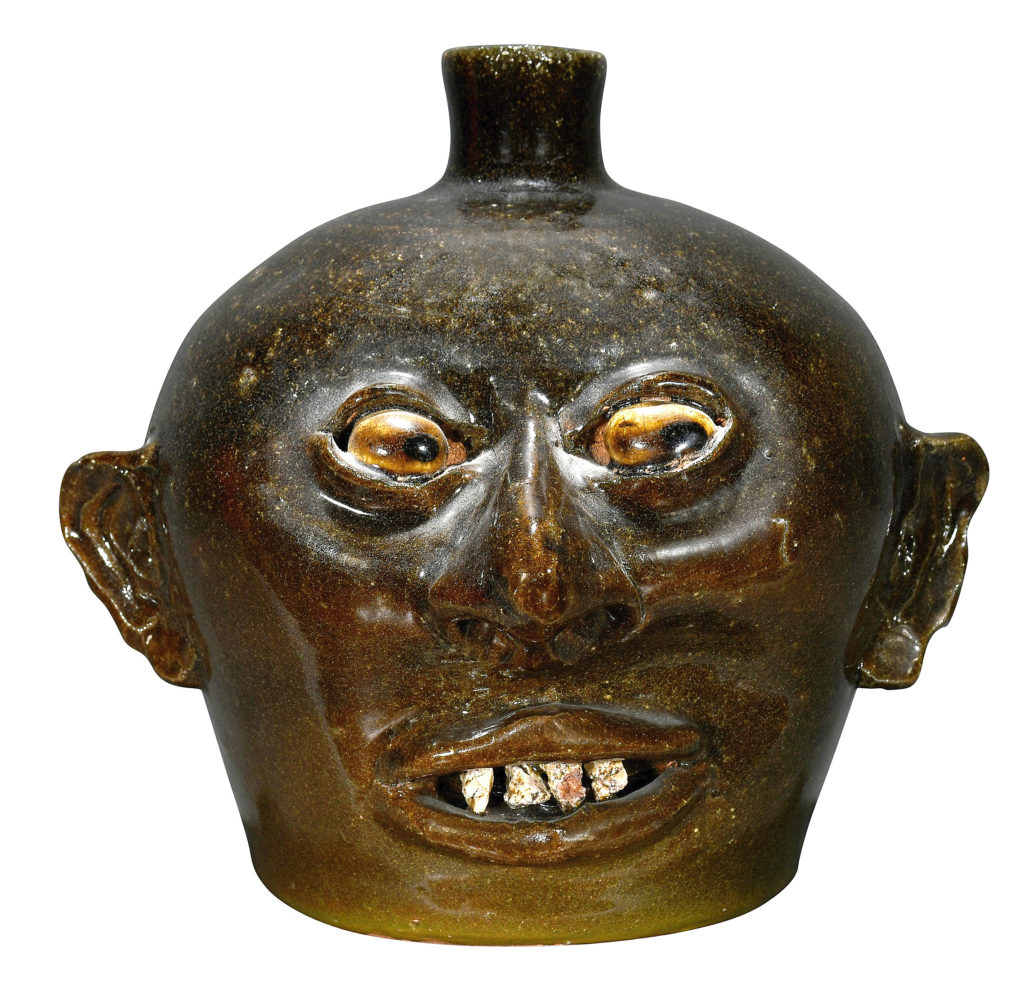
The best of the six Lanier Meaders face jugs sold, this early rock tooth example brought $8,125 ($3/5,000).
Slotin auctions, like many others, always have a few surprises. This sale’s eye-opener was a William Dawson (1901-1990) carved and painted totem walking cane from the Bowman collection. Estimated to bring $2/4,000, it surprised everyone with a $33,750 result. Other Dawson lots, also from the Bowmans, included his carved and painted wood “Man Wearing a Hat” and “Man with Brightly Colored Shirt “selling for $5,625 and $4,375, respectfully. All six Dawson lots met or exceeded their estimates.
Other carved wood lots included six works by Edgar Tolson (1904-1984), five by Steve Ashby (1904-1980) and three by Charlie Wiletto (1897-1964), all of which met or exceeded the experienced and educated catalog estimates. The top Tolson lot was his “Black Adam and Eve in the Garden” with painted Adam, Eve and snake for $18,125. Ashby’s carved and painted form with mixed media “Male Figure” stared from the front cover resulting in a $10,000 sale. At $6,125, Willeto’s carved and painted Navajo “Sacred Owl” flew beyond its $3/5,000 estimate.
Slotin Folk Art’s next sales include its August “Fun Folk Art Auction” event, date TBA, followed by the traditional Fall Self-Taught Art Masterpiece Sale on November 11-12.
Prices quoted include the buyer’s premium as reported by the auction house. For more information, 770-532-1115 or www.slotinfolkart.com.

